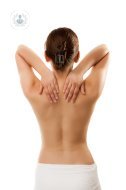Fixings for spinal instability
Written by:  In cases where lumbar disc herniation or by the symptoms that tells the patient or by the findings of x-rays or MRI, suspect a spinal instability is necessary to perform a technique to correct the instability .
In cases where lumbar disc herniation or by the symptoms that tells the patient or by the findings of x-rays or MRI, suspect a spinal instability is necessary to perform a technique to correct the instability .
The trauma offers different fastening systems, among which are rigid pedicle screws, semi-rigid and dynamic systems, interspinous fixation systems, ligamentoplastias, etc ... The choice of procedure will be individualized in each case, depending on factors such as the degree of instability, age, type of work ...
Spine surgery by transpedicular fixation
This fixing system is the placement of screws through the vertebrae, usually one on each side and bind with other vertebrae screws, bars or plates by. When the aim of the intervention is to get a complete spinal fusion, we use rigid plates or rods, associated to the placement of bone for good fusion. In instances where a fusion is not wanted, the junction between the screws will take place with rigid or dynamic positioning systems and will not be held bone. Likewise, both have mixed systems that allow us to combine fixed segments with dynamic segments.
Spine surgery f ixing interspinous
When the degree of instability of the spine is less, instead of using a transpedicular fixation system, we can use this procedure less invasive. It involves the placement of a device between the spinous processes that are in the back of the vertebrae. This device gives greater stability to the affected lumbar segment and prevents overloading of the facet joints. This technique is performed without further aggression on the column. And the goal is not to get a fusion-rigidity of the vertebrae but stabilize the segment.
L spinal surgery by igamentoplastia
We used also in lesser degrees of instability or in cases where the use of more invasive procedures are contraindicated, as is the transpedicular fixation. The ligamentoplasty is to strengthen the union with a synthetic spinal cord is interlaced between the spinous processes of the vertebrae. This device reinforces the column affected segments without fuse the vertebrae.
Spine surgery Interbody ixing f (PLIF-ALIF-TLIF)
Involves the placement of two implants (titanium & peek) generally fills bone material between the vertebral bodies. After the complete removal of the disc, are placed in place such implants, either by anterior approach (ALIF), posterior (PLIF) or lateral (TLIF) in order to merge the two vertebral bodies.
What are the complications of URGERY column?
Neurological ie, low by damaging the nerve roots transitional type of pain, tingling, or also persistent type (0.8 to 1.9%).
-Infection Wound at 0.9%.
-out Of cerebrospinal fluid in the 0.1 to 0.9%.
-Complications Due to the surgical site.
Lesions in abdominal vessels and / or ureter and / or other abdominal organs (rare but severe), 1 in 6,000- 8,000 lumbar disc surgery.
-Complications In other organs (pneumonia, gastritis, gastrointestinal bleeding, thrombophlebitis).
-Recidiva Hernia that needs a second operation.
-Risk Of death (0.02%)


